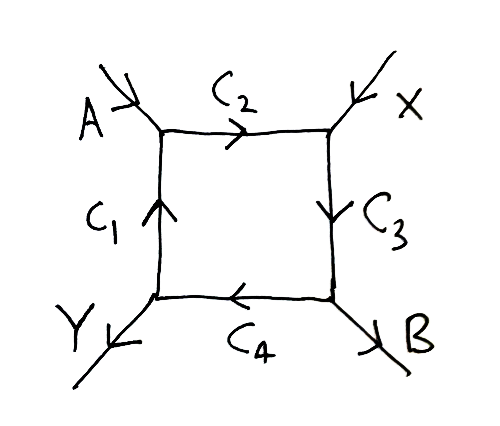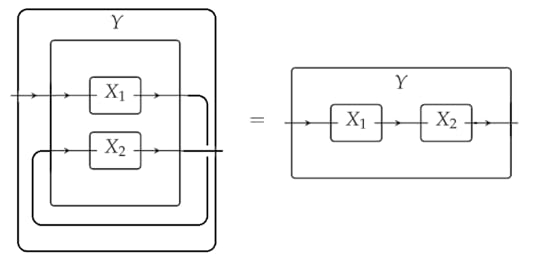John C. Baez's Blog, page 57
June 30, 2018
Coupling Through Emergent Conservation Laws (Part 5)
joint post with Jonathan Lorand, Blake Pollard, and Maru Sarazola
Coupling is the way biology makes reactions that ‘want’ to happen push forward desirable reactions that don’t want to happen. Coupling is achieved through the action of enzymes—but in a subtle way. An enzyme can increase the rate constant of a reaction. However, it cannot change the ratio of forward to reverse rate constants, since that is fixed by the difference of free energies, as we saw in Part 2:

and the presence of an en...
June 29, 2018
Coupling Through Emergent Conservation Laws (Part 4)
joint post with Jonathan Lorand, Blake Pollard, and Maru Sarazola
We’ve been trying to understand coupling: how a chemical reaction that ‘wants to happen’ because it decreases the amount of free energy can drive forward a chemical reaction that increases free energy.
For coupling to occur, the reactant species in both reactions must interact in some way. Indeed, in real-world examples where ATP hydrolysis is coupled to the formation of larger molecule  from parts
from parts  and
and  it is observed that, as...
it is observed that, as...
June 28, 2018
Coupling Through Emergent Conservation Laws (Part 3)
joint post with Jonathan Lorand, Blake Pollard, and Maru Sarazola
Last time we gave a quick intro to the chemistry and thermodynamics we’ll use to understand ‘coupling’. Now let’s really get started!
Suppose that we are in a setting in which some reaction

takes place. Let’s also assume we are interested in the production of  from
from  and
and  but that in our system, the reverse reaction is favored to happen. This means that that reverse rate constant exceeds the forward one, let’s say by a lot:
but that in our system, the reverse reaction is favored to happen. This means that that reverse rate constant exceeds the forward one, let’s say by a lot:

so...
June 27, 2018
Coupling Through Emergent Conservation Laws (Part 2)
joint post with Jonathan Lorand, Blake Pollard, and Maru Sarazola
In what follows, we will be working with reaction networks. A reaction network consists of a set of reactions, for example

Here X, Y and XY are the species involved, and we interpret this reaction as species X and Y combining to form species XY. We call X and Y the reactants and XY the product. Additive combinations of species, such as X + Y, are called complexes
The law of mass action states that the rate at which a reaction...
June 26, 2018
Coupling Through Emergent Conservation Laws (Part 1)
joint post with Jonathan Lorand, Blake Pollard, and Maru Sarazola
In the cell, chemical reactions are often ‘coupled’ so that reactions that release energy drive reactions that are biologically useful but involve an increase in energy. But how, exactly, does coupling work?
Much is known about this question, but the literature is also full of vague explanations and oversimplifications. Coupling cannot occur in equilibrium; it arises in open systems, where the concentrations of certain chemical...
A Biochemistry Question
Does anyone know a real-world example of a cycle like this:

or in other words, this:

where the reaction

is exergonic (i.e., involves a decrease in free energy) while

is endergonic (i.e., involves a free energy increase)?
The idea is that the above cycle, presumably catalyzed so that all the reactions go fairly fast under normal conditions, ‘couples’ the exergonic reaction, which ‘wants to happen’, to the endergonic reaction, which doesn’t… thus driving the endergonic one.
I would...
June 18, 2018
The Behavioral Approach to Systems Theory

Two more students in the Applied Category Theory 2018 school wrote a blog article about something they read:
• Eliana Lorch and Joshua Tan, The behavioral approach to systems theory, 15 June 2018.
Eliana Lorch is a mathematician based in San Francisco. Joshua Tan is a grad student in computer science at the University of Oxford and one of the organizers of Applied Category Theory 2018.
They wrote a great summary of this paper, which has been an inspiration to me and many others:
• Jan Wi...
June 16, 2018
Dynamical Systems and Their Steady States

As part of the Applied Category Theory 2018 school, Maru Sarazola wrote a blog article on open dynamical systems and their steady states. Check it out:
• Maru Sarazola, Dynamical systems and their steady states, 2 April 2018.
She compares two papers:
• David Spivak, The steady states of coupled dynamical systems compose according to matrix arithmetic.
• John Baez and Blake Pollard, A compositional framework for reaction networks, Reviews in Mathematical Physics 29 (2017), 1750028.
(Blog ar...
June 15, 2018
Applied Category Theory 2018/2019
A lot happened at Applied Category Theory 2018. Even as it’s still winding down, we’re already starting to plan a followup in 2019, to be held in Oxford. Here are some notes Joshua Tan sent out:
Discussions: Minutes from the discussions can be found here.Photos: Ross Duncan took some very glamorous photos of the conference, which you can find here.
Videos: Videos of talks are online here: courtesy of Jelle Herold and Fabrizio Genovese.
Next year’s workshop: Bob Coecke will be organizin...
June 14, 2018
Cognition, Convexity, and Category Theory

Two more students in the Applied Category Theory 2018 school wrote a blog article about a paper they read:
• Tai-Danae Bradley and Brad Theilman, Cognition, convexity and category theory, The n-Category Café, 10 March 2018.
Tai-Danae Bradley is a mathematics PhD student at the CUNY Graduate Center and well-known math blogger. Brad Theilman is a grad student in neuroscience at the Gentner Lab at U. C. San Diego. I was happy to get to know both of them when the school met in Leiden.
In their...
John C. Baez's Blog
- John C. Baez's profile
- 29 followers



